
Cripple Creek is a statutory city that is the county seat of Teller County, Colorado, United States. The city population was 1,155 at the 2020 United States Census. Cripple Creek is a former gold mining camp located 20 miles (32 km) southwest of Colorado Springs near the base of Pikes Peak. The Cripple Creek Historic District, which received National Historic Landmark status in 1961, includes part or all of the city and the surrounding area. The city is now a part of the Colorado Springs, CO Metropolitan Statistical Area and the Front Range Urban Corridor.

Leadville is a statutory city that is the county seat, the most populous community, and the only incorporated municipality in Lake County, Colorado, United States. The city population was 2,633 at the 2020 census. It is situated at an elevation of 10,158 feet (3,096 m). Leadville is the highest incorporated city in the United States and is surrounded by two of the tallest peaks in the state.

Central City is a home rule municipality located in Gilpin and Clear Creek counties, Colorado, United States. Central City is the county seat and the most populous municipality of Gilpin County. The city population was 779, all in Gilpin County, at the 2020 United States census. The city is a historic mining settlement founded in 1859 during the Pike's Peak Gold Rush and came to be known as the "Richest Square Mile on Earth". Central City and the adjacent city of Black Hawk form the federally designated Central City/Black Hawk Historic District. The city is now a part of the Denver–Aurora–Lakewood, CO Metropolitan Statistical Area and the Front Range Urban Corridor.

Gilpin County is a county located in the U.S. state of Colorado, smallest in land area behind only the City and County of Broomfield. As of the 2020 census, the population was 5,808. The county seat is Central City. The county was formed in 1861, while Colorado was still a territory, and was named after Colonel William Gilpin, the first territorial governor.
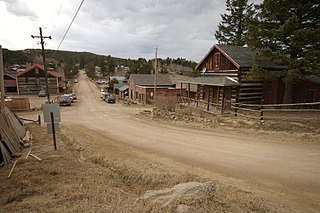
Gold Hill is an unincorporated community and a census-designated place (CDP) located in and governed by Boulder County, Colorado, United States. The CDP is a part of the Boulder, CO Metropolitan Statistical Area. The population of the Gold Hill CDP was 218 at the United States Census 2020. The Boulder post office serves the area.

Lake City is a statutory town that is the county seat, the most populous community, and the only incorporated municipality in Hinsdale County, Colorado, United States. The population was 432 at the 2020 census. It is located in the San Juan Mountains in a valley formed by the convergence of Henson Creek and the headwaters of the Lake Fork of the Gunnison River about seven miles (11 km) east of Uncompahgre Peak, a Colorado fourteener. Lake City is named after nearby Lake San Cristobal. This area lies at the southern end of the Colorado Mineral Belt and when rich mineral deposits were discovered the native population was pushed from their tribal lands and the town of Lake City was incorporated in 1873.
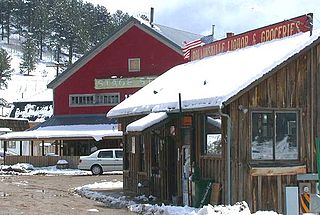
Rollinsville is a census-designated place (CDP) and post office in and governed by Gilpin County, Colorado, United States. The CDP is a part of the Denver–Aurora–Lakewood, CO Metropolitan Statistical Area. The Rollinsville post office has the ZIP Code 80474. At the United States Census 2020, the population of the Rollinsville CDP was 194.

Nathaniel Peter Hill was a professor at Brown University, a mining executive and engineer, and a politician, including serving in the United States Senate. Originally from the state of New York, he came to Colorado following the Pike's Peak Gold Rush to try his hand at mining. He traveled to Europe to investigate ways to smelt ore and developed processes to make mining more profitable. He was the mayor of Denver before becoming a United States Senator.
Eben Smith was a successful mine owner, smelting company executive, railroad executive and bank owner in Colorado in the late 19th century and early 20th century.
The Central City Parkway is a four-lane, 8.4 miles (13.5 km) highway in Clear Creek and Gilpin counties in Colorado, United States, that connects Interstate 70/U.S. Route 6/U.S. Route 40, immediately south of Central City with Nevadaville Road and Nevada Street in the historic mining town and gambling area of Central City. Opened on November 19, 2004, the Parkway provides direct access to Central City. The length of the Parkway can be traveled in about twelve minutes. As part of the opening ceremonies in 2004, 1996 Indianapolis 500 winner, Buddy Lazier, made the trip from I-70 to Central City's historic downtown in three minutes.

The Gilpin Railroad, earlier the Gilpin Tramway Company, was a 2 ft narrow gauge railway in Gilpin County, Colorado, in operation from 1887 to 1917.

The Central City/Black Hawk Historic District is a National Historic Landmark District that encompasses the developed areas of Central City and Black Hawk, Colorado, United States. They are adjacent former gold mining camps in the Front Range of the Rocky Mountains in Gilpin County, Colorado. For a time, the area was known as the Richest Square Mile on Earth, and was the largest urban area of the Colorado Territory in the 1870s.
Gold mining in Colorado, a state of the United States, has been an industry since 1858. It also played a key role in the establishment of the state of Colorado.
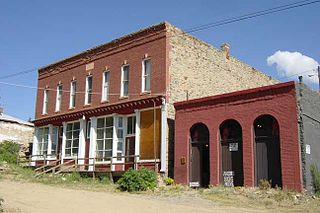
Nevadaville was a gold-mining town in Gilpin County, Colorado, United States. It was also known in the 1860s and 1870s as Nevada City. The post office at Nevadaville was called the Bald Mountain post office, to avoid confusion with other Nevadas and Nevadavilles. The community is now largely a ghost town, although not completely deserted. The Nevadaville Masonic Temple that started in 1861 still holds regular meetings.

The Leadville mining district, located in the Colorado Mineral Belt, was the most productive silver-mining district in the state of Colorado and hosts one of the largest lead-zinc-silver deposits in the world. Oro City, an early Colorado gold placer mining town located about a mile east of Leadville in California Gulch, was the location to one of the richest placer gold strikes in Colorado, with estimated gold production of 120,000–150,000 ozt, worth $2.5 to $3 million at the then-price of $20.67 per troy ounce.

Russell Gulch, is a former mining town, now largely a ghost town, in Gilpin County, Colorado, United States. Although the population was once much larger than today, and most of the larger commercial buildings stand empty, the town is not completely deserted.

Colorado Amendment 50 was a citizen's initiative that amended the Colorado state constitution to:
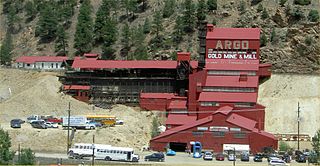
The Argo Gold Mine and Mill is a former gold mining and milling property in Idaho Springs, Colorado, featuring an intact gold mill built at the entrance of the Argo Tunnel. The tunnel was built between 1893 and 1910 to drain the gold mines in Virginia Canyon, Gilpin Gulch, Russell Gulch, Quartz Hill, Nevadaville, and Central City and allow easier ore removal. The success of the tunnel as an access route meant that a large volume of ore began exiting at the Idaho Springs entrance and a large mill was built to process it. At the time it was one of the largest such tunnels and milling operations in the world, directly recovering nearly $100 million in gold valued in 2023 at $10.1 trillion. They also sent another $200 million of high-value ores to smelters in Denver.
The Cripple Creek Gold Rush was a period of gold production in the Cripple Creek area from the late 1800s until the early 1900s. Mining exchanges were in Cripple Creek, Colorado Springs, Pueblo and Victor. Smelting was in Gillett, Florence, and (Old) Colorado City. Mining communities sprang up quickly, but most lasted only as long as gold continued to be produced. Settlements included:
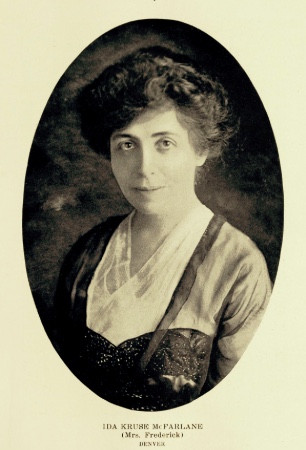
Ida Kruse McFarlane (1872-1940) was an English professor and head of the English department at the University of Denver. In 1931, she negotiated to have the Central City Opera House donated to the university.





















